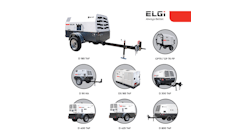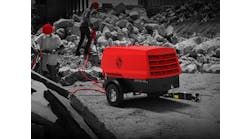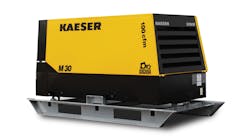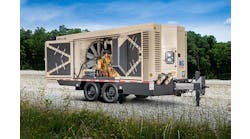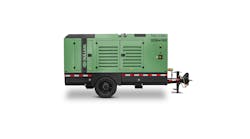Maintaining a steady flow of tool rentals is a basic goal for any rental center. To achieve this goal, every tool in the fleet must be kept in a constant state of readiness, so that every rental opportunity is utilized.
Ensuring that your air tools are always "ready to go" requires a few simple, dedicated procedures for receiving them from their last job and preparing them for the next one. Implementing a rental-ready program is an easy, cost-effective way to build your air tool rental business and give a boost to your bottom line. Following are some of the elements a good rental-ready program should include.
Return from rental When a tool is returned by a customer from rental, it should first be thoroughly cleaned. The exterior should be pressure-washed or steam-cleaned to remove dirt and grit that enter through the exhaust ports or the inlet during use.
After cleaning the outside, inspect the inlet, exhaust ports and the chuck. If foreign material remains, disassemble the tool and clean as needed. When the tool is clean, the mechanic can effectively inspect it for broken or worn parts.
While specific checkpoints will vary according to the type and manufacturer of the tool, there are components inherent in most pneumatic tools that should be part of every returned tool checklist.
Visual inspection * All component parts should be free of cracks or deformities in main housings or flange areas. On handles and other fastened components, the bolts and nuts should be checked with a torque wrench for proper tightness, according to the manufacturer's specifications.
* Throttle levers should be straight and the holes at the pivot points should be round to ensure proper, safe operation. Throttle levers will show wear at the pivot points as the holes become elongated; they will appear more oval than round.
* Chuck bushings can be evaluated either visually, by checking for rounding in the angles that form the hex shape; or physically, by inserting a new piece of steel into the tool and looking for any excess movement the bushing allows.
* Retaining latches, particularly in breakers, demolition tools and chipping hammers, are likely to suffer the most physical abuse during a rental. Since their sole purpose is to ensure that the steel stays in the tool, it is critical that retainers are regularly maintained and kept in good working order.
Latch-type retainers used on most breakers and demolition tools will show visible wear on the top of the "lip," the result of impact from the collar on the steel when the tool is operated with little or no pressure against the work piece. "Blank" or "dry" firing is most evident by indentations, mushrooming, chipping or fractures on the latch lip. A worn retainer, indicated by rubbing, cracks or breaks in the latch handle, will also tend to flutter or open during operation. Check the latch roll pins or bolts, and replace any that are insecure.
For chipping hammers, it is best to remove the retainer from the tool and inspect the interior. Check the impact points on the inside for excessive wear, chips or fractures. If the retainer is held in with a spring, examine it for flat or thinned areas. This is evidence of blank firing and suggests the need for a closer inspection of the retainer itself. It is recommended that the retainer spring be replaced after every rental as a part of your rental-ready routine.
Mechanical inspection After completing the visual inspection, add a small amount of air tool oil to the air inlet and connect an air line to the tool. Securely mount the tool to a test pad or dirt tamping pad (excellent for paving breakers and chipping hammers) and run the tool to ensure proper operation. Remember to use safety glasses and hearing protection, and to secure safety clips on all hose connections before operating air tools. Rock and utility drills require a slab of concrete or granite for loaded performance testing. Retired concrete barriers from local highway works make great test surfaces for most air tools.
If any tool or tool component appears to be damaged, or fails at any time during mechanical testing, it should be disassembled and repaired, according to the manufacturer's recommendations.
Presentation and perception Once the tool has passed the testing procedure, touch it up with a coat of paint, if needed. This not only revitalizes the finish of the tool, but also reflects positively on your commitment to customer service. Given a choice, most customers like to rent new equipment; they have greater confidence that a newer tool will perform better during their rental. As a result, they perceive a better value for the money they spend.
Complete the process by helping your employees recognize when tools are rental-ready. Use color-coded tags that say, "This tool has been checked by (name)." Allowing your maintenance personnel to sign and date their work encourages a sense of pride and achievement. It also indicates to your customer that the tools have been personally checked and maintained.
Benefits Every rental center can profit by creating a readiness program to capitalize on the tool rental needs of contractors, large and small. The cost of establishing a rental-ready program is modest when compared to the long-term benefits:
* Longer tool life. By keeping your tools in top condition, you build confidence. Remember that the customer's view of your company is affected by the reliability and performance of the equipment on the job. Also, by maintaining your tools, you are extending their life cycle and increasing the return on your original investment as well.
* Enhanced image. A display of clean, well-maintained, ready-to-work tools in your showroom is a reflection of your company's professional approach to doing business.
* Increased business. It's important to recognize that, in most instances, contractors rent more than just tools. They also rent compressors, light towers, generators and other construction products, and they often look for a single source to supply all their rental equipment needs. Displaying tools that are rental-ready indicates that you take pride in your rental equipment and increases your value to the contractor looking for a "one-stop" rental equipment supplier.
* Improved bottom line. The small manpower investment necessary to keep your tools rental-ready is more than offset by the increased return generated by higher utilization rates. By having your tools on the job, instead of on the workbench, you raise the potential rental income from each tool.
